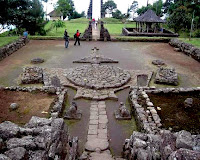 |
| Cetho Temple |
The countryside on Gunung Lawus slopes is amazing. Rolling hills, valleys and plateaus, coffee groves and vegetable plots give way to tea plantations at about 1,000 m. At 1,400 m and some fifteen kilometres from Temple Sukuh lies Temple Cetho which sits at the top of a steeply sloping Hindu village of the same name. It dates from the same period as Sukuh, but could not be more different. It is an exquisitely attractive place, even if little visited. |
| Cetho Temple |
Temple Cetho (Javanese spelling: ceth) is a Hindu
temple-style relics of the end of the Majapahit (15th century). The first scientific report about it was made by Van de Vlies in 1842. A.J. Bernet Kempers also do some research about it. Excavation (digging) for the purpose of reconstruction was first performed in 1928 by the Archaeological Department of the Dutch East Indies. Under the circumstances when the ruins began to study, this
temple has not aged that much with Sukuh. This
temple is located in the hamlet of Ceto, Gumeng Village, District Jenawi, Karanganyar district, at an altitude of 1400m above sea level.
 |
| Cetho Temple |
When was found, the state of this
temple is a stone ruins on the fourteen-story plains, extending from the west
(lowest) to the east, although at present there are only 13 terrace, and the restoration carried out only nine terraces. Structure with many terraces, making up the prediction of the original culture revival ("punden staircase") at the time, which is synthesized by the Hindu religion. This suspicion is strengthened by the body shape in relief that like a puppet, which is similar to the depiction in Sukuh.In the "
temple Cetho" there is a symbol of phallus (penis, male genitalia) about 2 meter long, equipped with a decorative piercing (piercing) of ampallang type.
In addition there are depictions of other animals, such as horseshoe crabs, frogs, and crayfish. Animal symbols that exist, can be read as "suryasengkala" with the number of 1373 Saka, or 1451 in the modern era.
 |
| Cetho Temple |







 1:27 AM
1:27 AM
 Unknown
Unknown

 Posted in:
Posted in: 




0 comments:
Post a Comment